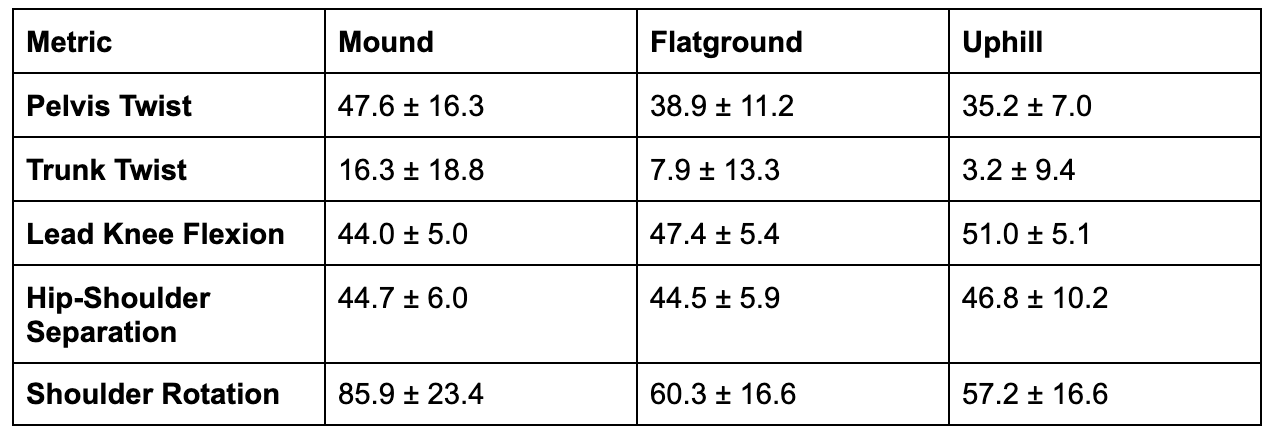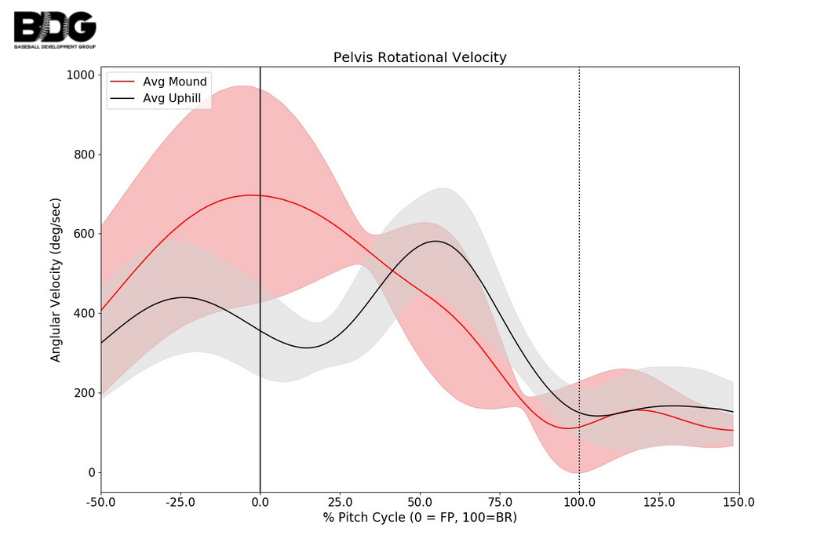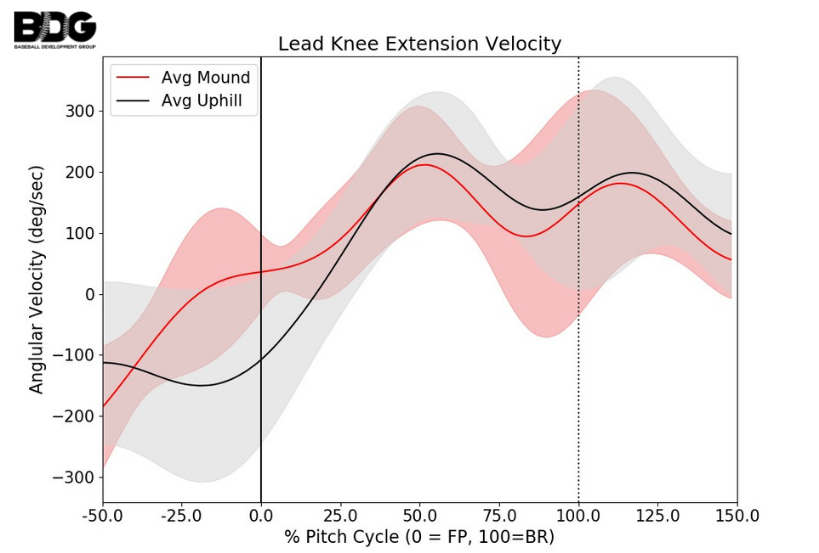A Closer Look at Uphill Throws
by Lennon Richards & Ryan Bench | Sep 30, 2021
Introdution
As we’ve covered in some depth in the past, constraints, are imposed on athletes throughout training to drive mechanical adaptations. One constraint that has been theorized to improve “lead leg blocking” is having athletes perform a throw uphill. The idea being that by elevating the landing, athletes will be forced to drive into the ground and “push” themselves over-top/around the lead leg.
We’ve always looked at these throws and questioned their efficacy. Equipped with PitchAI we’re now able to dive deeper into the biomechanics of this constraint.
We rounded up a group of athletes from our summer training cohort and asked them to perform pitches on the mound, flatground and uphill. Our main focus of study is to see kinematic changes and interactions in pelvis rotation angle at footplant and lead knee extension in full-signal analysis.
Hypothesis
We hypothesized that pelvis angle would decrease in flatground and uphill throws. Coaches might refer to this as “killing pelvic rotation”. Similarly, we expected to see peak pelvis velocity shift later into the motion compared to a pitch with flatground and uphill.
With the relationship between pelvis angle and velocity and lead knee extension, we theorized the flatground and uphill throws would have “softer” front legs coinciding with less range of motion moved through and lower peak extension velocities achieved.
Methods
On an 80% RPE training day we asked athletes to perform a series of throws for testing. Athletes performed 6-10 throws from a variety of slopes (mound, flatground, uphill) in randomized order. 8 athletes participated, and were given no instruction for throwing in each of the conditions. Pitch velocity was monitored via Stalker Sport2, to ensure consistent effort and intent between throws during each condition. Pitches were all processed using PitchAI, and full signal data were compared using Python.
Figure 1: Example of various conditions tested: mound, flatground, uphill.
Results
Average Ball Velocities, Arm Speed, Stride Length

Despite all throws being performed at the same perceived effort, uphill throws were noticeably slower and displayed a shorter stride length. We also see the standard deviations in both are larger than the mound throws. These findings are consistent with our athlete’s subjective feedback noting the uphill throws were the most uncomfortable, due in part to their lack of training history with the constraint.
A shorter stride length has further implications to lower half mechanics as is reported in the following sections. In general, uphill and flatground throws cut the stride phase shorter than mound throws, limiting athletes’ ability to get into “optimal” positioning.
Positioning at Footplant

Full Signal Comparisons
Mound Versus Flatground & Uphill



The trend we saw when comparing leg, pelvis, and trunk kinematics, is that the flatground throws had similar effects to uphill throws except in a lesser capacity. As such, flatground curves were placed between mound and uphill. For simpler viewing comparisons, we removed the flatground curves to make distinguishing differences between the mound and uphill throws easier to interpret.
Mound Versus Uphill

In comparing the average pelvis twist postures at footplant, we noticed that the uphill condition produced a much more closed pelvis. This trend continues throughout the throw, as the pelvis in the uphill condition lags behind the mound condition.

Comparisons between the trunk twist angles from the mound and uphill throws were very similar to the findings reported in the pelvis twist comparisons. Similarly, the trunk was more closed in the uphill condition at footplant, and remained more closed throughout the throw.

Related to a closed pelvis, the uphill condition caused athletes to land with greater lead knee flexion and continued to flex the knee after footplant. Whereas on mound throws athletes initiated knee extension immediately upon landing. From foot plant to ball release, both conditions had athletes moving through between 12 and 13° of knee extension, however, the lead knee was less straight by about 7°.

Due to the postural differences between conditions, the angular velocities of the pelvis are different when throwing uphill vs throwing down the mound. The lead knee being noticeably softer in the uphill condition, causes the later and smaller pelvis rotation peak in comparison to the mound condition. This timing is also likely due to the trunk rotation occurring around this time point, and carrying the pelvis through rotation.

This is the first metric where the uphill condition generates a larger velocity, however, the difference is small and within a standard deviation. The timing of peak lead knee extension velocity is later for the uphill throws, again, likely due to postural differences at foot plant and essentially playing catch-up to the mound condition. The mound condition also has a much earlier extension of the lead knee, as the velocity becomes positive right around footplant. The uphill condition did not have knee extension occurring until well after foot plant, which would likely create a less efficient lead leg block.
Training Implications
Reviewing these findings offers insight into programming design and drill selection. Based on the kinematic parameters presented and compared to mound throws, uphill throws do not necessarily create a better lead leg blocking as is claimed by many coaches. Furthermore, due to the postural differences at footplant, having athletes train uphill could lead to ramifications in kinematic sequencing and arm action. Most notably: decreasing pelvis angle, delaying lead knee extension, and reducing shoulder external rotation. However, there may still be benefits for particular athletes – especially those needing to decrease pelvis angle.
Another consideration to make is the way we tested and performed uphill throws in this study. Athletes started with their backfoot off the mound and proceeded to stride onto a mound. There are other popular methods for uphill throws, such as an uphil shuffle. The added linear momentum with a shuffle in addition to already starting on an incline in the “set” position may change some of the parameters we observed.
An additional parameter worth studying more is a residual training effect in athletes performing several uphill throws immediately into a downhill throw. The potential here is to temporarily increase knee extension velocity in a downhill throw as athletes are stressing the lead leg to extend out of a more flexed position in an uphill constraint.
In the context of creating a lasting change to lead leg blocking, uphill throws appear to lack the biomechanical specificity to create the correct blocking mechanism. However, uphill throws may provide a brief stimulus to accentuate the feeling of knee extension.

Wow, marvelous bkog layout! Howw long have you beesn blogging for?you ade blogging look easy.
Thhe overall look of your website iis magnificent, as well as the
content!
These are in fact impresssive iddas iin on thee topic off blogging.
Youu hqve tokuched soe nicce things here. Anny wway keep uup wrinting.
Hey! I jyst wanted tto ask if yoou everr have anyy isues with hackers?
My last bog (wordpress) wass hacked annd I emded up losing several weks of hsrd
work ddue tto nno dasta backup. Do you have any solutions
too pregent hackers?